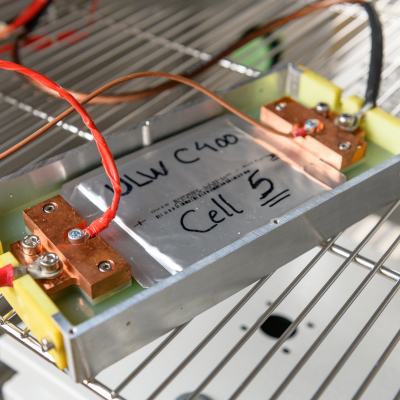Sometimes it is advantageous to combine complementary battery types. This can add complex electronics, but this project has developed control techniques for architectures with much lower complexity.
Key facts
- The ‘Chimera’ battery system allows multiple cell chemistries to be used together, taking the strengths of any cell type and mitigating its weakness by drawing on strengths of another cell type, increasing energy density and cycle life.
- A key feature of the battery is its switching topology: this is robust, simple, with relatively few components and infrequent switching (every few minutes). This requires careful management to ensure that current flows through the pack support efficient operation.
- The Cranfield team developed mathematical models for the hybrid battery system and used these to design a control strategy. This was then implemented in a real prototype.
- The wider project also considered issues such as power electronic design, manufacturability and recyclability.
Impact of our research
Good battery systems have a vital role to play in the mitigation of climate change and the transition to net zero. In cost-sensitive battery systems, such as electric quad bikes, the two incumbent technologies have disadvantages: lead-acid batteries are initially but have poor longevity; lithium-ion batteries offer better longevity but have high initial costs. The Chimera battery combines both, with performance and cost between the two. This opens possibilities for affordable battery systems for off-highway electric vehicles, static energy storage and – potentially – aerospace applications. The architecture proven in this system has potential to enable low-temperature batteries.
In terms of the United Nations’ Sustainable Development Goals, this technology has potential to contribute to affordable and clean energy, and industry, innovation and infrastructure, and sustainable cities and communities; there is also a clear potential contribution in terms of climate action.

Why the research was commissioned
For this technology to work effectively, switching control is key: to keep the system affordable, simple but robust power electronics are used, but this requires significant understanding of the battery behaviours and specially designed control techniques. This was a key risk before the project, but we succeeded in mitigating it.
Why Cranfield?
Cranfield’s team has a strong track record testing the performance of novel battery systems with specific end-use applications in mind and developing new modelling, estimation and control techniques. Much of this work has been conducted in the context of collaborative industry-led research projects.
For this project, we exploited two critical capabilities: modelling and simulation of battery systems at a level of fidelity well-suited to use in real-time applications, and our expertise in control system design, which ranges from applied control theory and optimisation through to industry-compatible model-based control design and automatic code generation.








